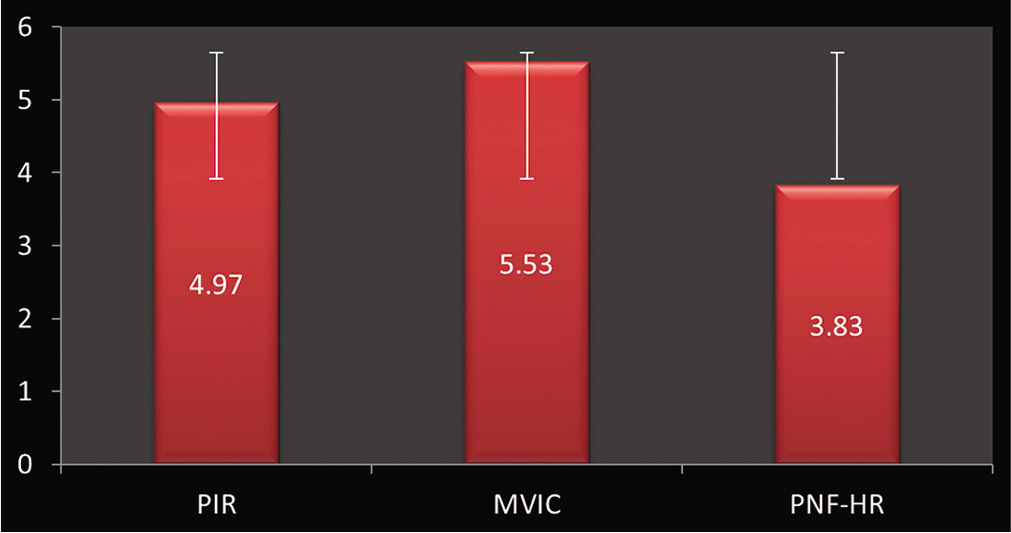Translate this page into:
Change in hamstrings flexibility: A comparison between three different manual therapeutic techniques in normal individuals

-
Received: ,
Accepted: ,
How to cite this article: Singh S, Kaushal K. Change in hamstrings flexibility: A comparison between three different manual therapeutic techniques in normal individuals. Adesh Univ J Med Sci Res 2020;2(1):49-51.
Abstract
Objectives:
The objectives of the study were to find the effective techniques out of post isometric relaxation, Maximum voluntary isometric contraction and PNF hold relax in increasing the flexibility of hamstring muscles.
Materials and Methods:
An observational study on 90 subjects (both sexes; between 18 and 30 years) was given one of three interventions – PIR, 10 Sec MVIC, and PNF HR and assigned into three groups – Group A, B, and C (each group with 30 subjects). Three repetitions of the protocol were given to each subject for regular 2 days. Active knee extension ROM was measured by the AKE test (90–90 test) before and after the treatment session both days. The data were collected, and percentage analysis was used to interpret the results.
Results:
All the groups showed a significant increase in active knee extension ROM. However, the results were more significant for Group B than Group A than Group C with mean differences 5.53, 4.97, and 3.83, respectively.
Conclusion:
Hence, it is concluded that 10 s, MVIC was the most effective among the three manual techniques.
Keywords
Hamstring
Flexibility
Active knee extension
Post-isometric relaxation
Maximum voluntary isometric contraction
PNF hold relax
INTRODUCTION
Flexibility is not only for players, gymnasts, and runners, but it is an important component for good physical fitness in daily life also.[1] The ability of an individual to move smoothly depends on flexibility, and it enhances the physical activity and reduces the risk of injury.[2,3]
The therapists commonly examine the tightness or shortness of muscle to assess flexibility. The shortening and tightness of a muscle cause decreased flexibility and reduced joint range of motion which ultimately leads to muscle imbalance.[4-6]
Lower limb flexibility involves various muscles such as hamstrings, quadriceps, and calf muscles, of which the hamstring muscles are most common to get affected.[7]
The reduced flexibility of hamstring muscles alters the mechanics of lower extremity and lumbopelvic region. The tight hamstring muscles have an effect on gait pattern, patella-femoral joint, planter fascia, pelvic tilt, and lumbopelvic rhythm.[8]
There are various techniques which are used to increase muscle flexibility and joint range of motions that such techniques include static stretching, PNF stretch, and massage therapy.[9-12] Muscle energy technique and maximum voluntary isometric contraction are the techniques that can also be used to improve the flexibility of muscles.[13,14]
Thus, the present study has included post-isometric relaxation technique of muscle energy technique, maximum voluntary isometric contraction, and hold-relax for the purpose to find out the effective way to increase the hamstring flexibility.
MATERIALS AND METHODS
The ethical clearance for the study was taken from the ethical committee of Adesh University. The 90 healthy subjects with tight hamstring muscles of age between 18 and 30 years were selected from Adesh University according to the selection criteria. Volunteer subjects of both sexes were included in the study. Subjects with an inflammatory condition of hip joint and knees, a congenital deformity of the lower limb, any musculoskeletal or neurological injury of the lower limb, history of back, knee pain, and the subjects who were taking corticosteroids from the past 6 months were excluded from the study. The verbal and written consent were taken from the subjects. The flexibility of hamstring muscles was measured using 90–90 active knee extension test for all the subjects before interventions. After pre-interventional measurement of hamstring flexibility, the randomized concealment was done with a sealed envelope to divide the subjects into three groups Group A, Group B, and Group C. Ten minutes of hot pack were given to all the three groups before interventions; then, post-isometric relaxation was given to Group A. The maximum isometric contraction was given to Group B and PNF hold-relax was given to Group C. The post- interventional flexibility of hamstring muscles was measured to compare the effectiveness of all three techniques.
Interventions
Group A was given post-isometric relaxation technique with 5 s of isometric contraction at approx. About 75% of the maximal effort of hamstring muscle followed by 3 s of relaxation for a total three repetitions. The Group B was given maximum voluntary isometric contraction of 10 s at the end of available ROM with a mild feeling of stretch for total three repetitions and the Group C was given PNF hold-relax technique with 7 s of stretch and hold of 3 s of isometric contraction followed by 5 s relaxation for a total of three repetitions. The intervention for each group was given for regular 2 days.
RESULTS
One-way ANOVA test was used to analyze the collected data of all the groups for statistical significance. Group A shows a significant improvement in hamstring flexibility with post- isometric relaxation. It shows the mean difference in pre- and post-values of range of motion of 4.97° with P = 0.0001. Group B shows a statistically significant improvement in hamstring flexibility with maximum voluntary isometric contraction with the mean value of 5.53° of range of motion with P = 0.0001, whereas Group C shows significant improvement with PNF hold-relax with a mean difference of 3.83° with P = 0.0001.

Graph showing mean improvement in AKE range of motion after post-isometric contraction, maximum voluntary isometric contraction, and PNF hold-relax.
DISCUSSION
The prime motive of the current study was to find out the best effective way to increase muscle flexibility out of three manual therapy techniques.
The purpose of the study was to compare the efficacy of post- isometric relaxation exercise 10 s of maximum voluntary isometric contraction and PNF hold-relax on hamstring tightness and three techniques show significant improvement in AKE range of motion, but the results were more significant for Group B, i.e., maximum voluntary isometric contraction with a mean improvement of 5.53° with P = 0.0001 and SD 1.2° followed by post-isometric technique with mean improvement of 4.97° with P = 0.0001 and SD 1.35° and the results were least significant for PNF-hold-relax with the mean improvement of 3.83° with P = 0.0001 and SD 0.87°.
A maximal static contraction of muscle stimulates autogenic inhibition. The force generated by viscous material to resist the stretch force of muscle gradually decreases over time with causes stress relaxation of muscle, and ultimately, it results in elongation of muscle,[15-18]
Whereas in both PNF hold-relax and post-isometric relaxation static stretch component are included, so the finding of PNF hold-relax and post-isometric relaxation resembles the sum finding of static stretching. The authors suggest that due to prolonged stretch, the number of sarcomere increases and as a result of this muscle elongation happens,[16,19] whereas the PNF hold-relax uses the effect of a stretch at maximum tolerance of stretch. MVIC/PNF HR technique on the hamstring muscle group, PIR, and PNF CR uses similar protocols, but differences can mostly be attributed to variability in contraction durations, force, and the number of repetitions used.[20-22] The PNF hold-relax technique shows effective in elongation of muscle due to neural inhibition of muscle being stretched, which reduces reflex activity and enhances relaxation.[18]
CONCLUSION
Based on the result of the study, all the three techniques post-isometric relaxation, maximum voluntary isometric contraction, and PNF hold-relax are significantly effective in increasing active knee flexion range of motion, but the 10 s, maximum voluntary isometric contraction is the most effective technique in increasing the active knee extension range of motion followed by post-isometric relaxation and the PNF hold-relax technique is the least effective technique of these techniques.
Declaration of patient consent
The authors certify that they have obtained all appropriate patient consent.
Financial support and sponsorship
Nil.
Conflicts of interest
There are no conflicts of interest.
References
- Comparative study on skill and health related physical fitness characteristics between national basketball and football players in Sri Lanka. BMC Res Notes. 2019;12:397.
- [CrossRef] [PubMed] [Google Scholar]
- Duration of maintained hamstring flexibility after a one-time, modified hold-relax stretching protocol. J Athl Train. 2001;36:44-8.
- [Google Scholar]
- The effects of static stretch duration on the flexibility of hamstring muscles. J Biomed Res. 2005;8:79-82.
- [CrossRef] [Google Scholar]
- Current concepts in muscle stretching for exercise and rehabilitation. Int J Sports Phys Ther. 2012;7:109-19.
- [Google Scholar]
- Assessment and Treatment of Muscle Imbalance: The Janda Approach Champaign, IL: Human Kinematics; 2010.
- [Google Scholar]
- A comparative study: Static stretching versus eccentric training on popliteal angle in normal healthy Indian collegiate males. Int J Sports Sci Eng. 2009;3:180-6.
- [Google Scholar]
- Thieme Atlas of Anatomy General Anatomy and Musculoskeletal System. Stuttgart, New York: Thieme; 2006.
- [Google Scholar]
- Increasing muscle extensibility: A matter of increasing length or modifying sensation? Phys Ther. 2010;90:438-49.
- [CrossRef] [PubMed] [Google Scholar]
- Acute effects of static and proprioceptive neuromuscular facilitation stretching on muscle strength and power output. J Athl Train. 2005;40:94-103.
- [Google Scholar]
- Investigation into the long-term effects of static and PNF stretching exercises on range of motion and jump performance. J Bodyw Mov Ther. 2009;13:11-21.
- [CrossRef] [PubMed] [Google Scholar]
- Effect of massage of the hamstring muscle group on performance of the sit and reach test. Br J Sports Med. 2004;38:349-51.
- [CrossRef] [PubMed] [Google Scholar]
- The effect of muscle energy technique on hamstring extensibility: The mechanism of altered flexibility. J Osteopath Med. 2003;6:59-63.
- [CrossRef] [Google Scholar]
- The effect of 15-sec of maximal voluntary isometric contraction and 10-sec of passive stretching on strength, endurance and flexibility of hamstring muscle. Ann Biol Res. 2012;3:908-12.
- [Google Scholar]
- Re-examination of the possible role of Golgi tendon organ and muscle spindle reflexes in proprioceptive neuromuscular facilitation muscle stretching. Sports Biomech. 2004;3:159-83.
- [CrossRef] [PubMed] [Google Scholar]
- Passive properties of human skeletal muscle during stretch maneuvers. A review. Scand J Med Sci Sports. 1998;8:65-77.
- [CrossRef] [PubMed] [Google Scholar]
- Viscoelastic properties of muscle-tendon units. Am J Sports Med. 1990;18:300-9.
- [CrossRef] [PubMed] [Google Scholar]
- Viscoelastic description of a collagenous tissue in simple elongation. J Appl Physiol. 1969;26:857-62.
- [CrossRef] [PubMed] [Google Scholar]
- Passive force, angle, and stiffness changes after stretching of hamstring muscles. Med Sci Sports Exerc. 2004;36:1944-8.
- [CrossRef] [PubMed] [Google Scholar]
- Mechanical and physical responses to stretching with and without preisometric contraction in human skeletal muscle. Arch Phys Med Rehabil. 1996;77:373-8.
- [CrossRef] [Google Scholar]
- Immediate effects of quantified hamstring stretching: Hold-relax proprioceptive neuromuscular facilitation versus static stretching. Phys Ther Sport. 2011;12:122-6.
- [CrossRef] [PubMed] [Google Scholar]
- Effect of PNF stretch techniques on knee flexor muscle EMG activity in older adults. J Electromyogr Kinesiol. 2002;12:391-7.
- [CrossRef] [Google Scholar]







